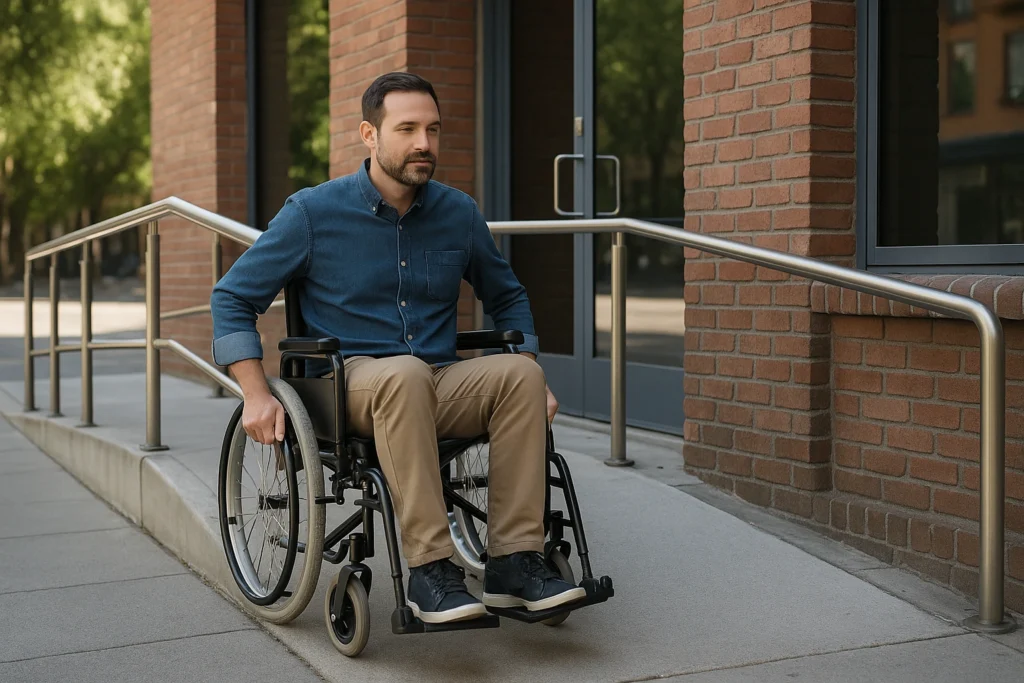
A sidewalk ramp, an accessible restroom, a captioned video—each of these traces back to the Americans with Disabilities Act (ADA). This landmark federal law transformed public spaces, workplaces, and digital platforms by providing people with disabilities the legal foundation to demand equal treatment and full participation. The ADA does more than ensure access; it challenges outdated systems and fosters change within communities. Understanding how the ADA works helps businesses, governments, and individuals create a fairer, more inclusive society.
What the ADA Does
The ADA protects people who have a physical or mental impairment that substantially limits one or more major life activities. It also covers individuals with a history of such impairments and those perceived as having one.
The law focuses on five main areas:
- Employment (Title I)
- Public Services (Title II)
- Public Accommodations (Title III)
- Telecommunications (Title IV)
- Miscellaneous Provisions (Title V)
Each section helps reduce discrimination and expand access to services and opportunities.
Title I: Equal Employment Opportunity
Title I of the ADA bars employers from discriminating against qualified individuals with disabilities. This applies to hiring, training, promotions, and job duties. Employers with 15 or more employees must follow the law.
Reasonable Accommodations in the Workplace
Employers must provide adjustments that allow individuals to perform essential job duties. These accommodations may include:
- Modified work schedules
- Accessible workspaces
- Assistive technology
- Interpreters or readers
Employers do not have to provide accommodations that cause undue hardship, such as excessive costs or major disruptions. However, most accommodations carry minimal cost.
Title II: Access to Public Services
State and local governments must make services accessible. This includes public education, voting, parks, libraries, and public transit systems. Agencies must modify policies when necessary to provide equal access.
Public Transportation Requirements
Buses and trains must accommodate individuals who use wheelchairs, are blind, or have other mobility or communication challenges. This may include lifts, ramps, audio announcements, and staff training.
Title III: Public Accommodations
Title III applies to businesses and nonprofits open to the public. This includes restaurants, hotels, theaters, stores, private schools, and medical offices.
These places must provide equal access. New construction and major renovations must meet ADA accessibility standards. Existing facilities must remove barriers when it is readily achievable.
Barrier Removal Examples
- Installing ramps
- Widening doorways
- Rearranging furniture
- Providing accessible parking
- Installing grab bars in restrooms
Staff must also provide reasonable modifications to policies and offer auxiliary aids when needed, such as providing menus in braille or using written notes for communication.

Title IV: Access to Telecommunications
Title IV requires telephone and internet companies to offer services that allow people with hearing or speech disabilities to communicate.
Telecommunications Relay Services (TRS)
TRS enables people who use text telephones (TTYs) or other devices to interact with voice telephone users through a communications assistant. The Federal Communications Commission (FCC) regulates TRS and captioned telephone services.
Title V: Additional Protections
Title V includes legal protections, definitions, and rules related to enforcement. It also prevents retaliation against individuals who exercise their ADA rights or support someone else in doing so.
ADA and Digital Accessibility
Technology continues to change how people work, learn, and connect. Although the original ADA focused on physical spaces, courts and government agencies now apply it to websites and digital platforms.
Website Accessibility Best Practices
Businesses and agencies must provide websites that people with disabilities can use. This includes:
- Text alternatives for images
- Clear headings and structure
- Keyboard navigation
- Video captions and transcripts
- Compatible screen reader formatting
Making websites accessible supports a broader audience and reduces the risk of lawsuits.
Why ADA Compliance Matters
ADA compliance goes beyond legal obligations. It reflects values of inclusion, respect, and opportunity.
Benefits of Accessibility
- Reaches a wider customer base
- Enhances brand reputation
- Improves employee satisfaction
- Reduces legal risk
- Promotes social responsibility
Compliance helps remove barriers and opens up participation in everyday life. It also improves experiences for aging populations, families with children, and people recovering from injury.

Common Misunderstandings About the ADA
Some businesses and individuals misunderstand how the ADA applies. These common myths create confusion and prevent progress.
1. “Only large companies must comply.”
Truth: Businesses with 15 or more employees must comply with Title I. Titles II and III apply to most public services and public-facing businesses, regardless of size.
2. “The ADA only applies to wheelchair users.”
Truth: The ADA covers a wide range of physical and mental disabilities, including visual, hearing, intellectual, and emotional impairments.
3. “If a building is old, nothing needs to change.”
Truth: Existing buildings must remove barriers if the change is easily achievable and low in cost. No one gets automatic exemption due to age of the property.
4. “Accommodations are always expensive.”
Truth: Many adjustments cost little or nothing. A simple change in procedure or layout often makes a big difference.
How to File an ADA Complaint
If someone believes a business, employer, or agency has violated the ADA, they can file a complaint with the appropriate agency.
Employment Discrimination
Contact the Equal Employment Opportunity Commission (EEOC). Complaints must be filed within 180 days of the incident, or 300 days if state law also applies.
Public Accommodations or Services
File a complaint with the Department of Justice (DOJ). Individuals can also sue in court without filing first with the DOJ.
Telecommunications
Contact the Federal Communications Commission (FCC) for issues related to phone and internet access.
Complaints should include a clear explanation of the issue, the dates involved, and copies of any communication with the other party.
ADA in Everyday Life
The ADA has improved many aspects of life for people with disabilities. Sidewalk ramps, talking crosswalks, and captioned TV programs now feel like standard features. These changes grew out of the fight for equal treatment.
Parents now advocate for school accommodations. Job seekers request tools that support their needs. Shoppers find accessible entrances and restrooms.
The ADA gave people a legal tool, but real progress comes when communities act on the spirit of the law. Inclusion starts with design, hiring, policies, and outreach. It grows with awareness, effort, and leadership.
Final Thoughts
The Americans with Disabilities Act (ADA) has opened doors for millions, making discrimination illegal and providing people with the tools to demand equal treatment. Its impact stretches across schools, workplaces, buses, stores, websites, and homes.
To continue making progress, it’s essential to understand the law, stand up when rights are denied, and create spaces that are welcoming to all. Businesses, schools, and public institutions can take simple steps that lead to lasting change.
Accessibility isn’t a one-time fix; it’s a daily commitment to include, support, and respect everyone. The ADA helps turn that commitment into action.
Other Related Articles
- Guardianship of Persons with Developmental Disabilities in Texas
- What Texans Should Know About Legal Guardianship For Adults With Disabilities In Texas
- Divorce Involving a Spouse with Disabilities in Texas
- Obtaining a Guardianship Over a Child With Disabilities in Texas
- Promoting Equality for People with Disabilities
- Military disability pay in a Texas divorce case
- Spousal Maintenance for a Disabled Spouse in Texas
- Alimony or Spousal Support and a Disabled Spouse in Texas
- Disabled Divorce in Texas
- Special Needs Trusts: What they are and how they can impact your Texas divorce
Americans with Disabilities Act FAQs
The Americans with Disabilities Act (ADA) is a federal law that prohibits discrimination against individuals with disabilities. It ensures equal opportunities in various areas of public life, including employment, education, transportation, and access to public services and facilities.
The ADA protects individuals with disabilities, which are defined as individuals who have a physical or mental impairment that substantially limits one or more major life activities, individuals with a history of such an impairment, and individuals who are regarded as having such an impairment.
The ADA requires covered entities to provide reasonable accommodations to individuals with disabilities to ensure equal access and participation. Accommodations may include modifications to policies, practices, or procedures, as well as physical modifications to facilities.
The ADA prohibits discrimination in all aspects of employment, including hiring, firing, advancement, compensation, and job training. Employers are required to provide reasonable accommodations to qualified individuals with disabilities unless it creates an undue hardship.
The ADA Amendments Act (ADAAA) was enacted to clarify the definition of disability under the ADA and to ensure that the definition is interpreted broadly to include a wider range of impairments. The ADAAA aimed to restore the original intent of the ADA and provide greater protection to individuals with disabilities.



